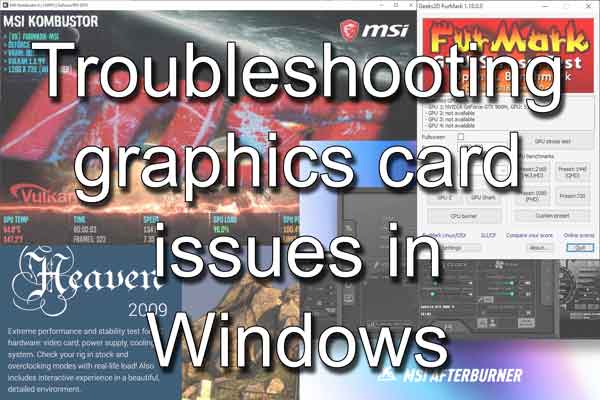Updated February 15, 2024
Are you having video problems when trying to play a game? Maybe your screen goes blank for a second or two? If so, here is how to troubleshoot the graphics card in your Windows-based computer.

If you are currently experiencing issues with the graphics on your computer, it may be due to a problem with your graphics card. You can take a few steps to diagnose the issue and potentially resolve the problem.
The first step is to check for updates. It's important to ensure that your graphics card drivers are up-to-date. To do this, you can visit the manufacturer's website and download the latest updates. This will ensure that your graphics card is functioning optimally and may resolve any issues you are experiencing.
Next, run a stress test. Using a graphics card stress testing tool, you can test your graphics card and identify potential issues. This will help you determine whether the problem lies with the card or another component of your computer.
The Ultimate Boot CD (UBCD) is a great diagnostic tool that includes a video memory stress test. All you have to do is download the latest ISO file and burn it to a CD/DVD or use Rufus to create a bootable USB drive.
You may have to change some settings in your motherboard's BIOS to get the UBCD to boot correctly. The UBCD is built on a Linux platform, so you may need to turn off secure boot and UEFI boot features temporarily.
Diagnose computer hardware issues with the Ultimate Boot CD
Create custom installation media with Rufus
While you test your graphics card, it is essential to monitor the temperature of your graphics card. High temperatures can cause issues with the card, so it's important to keep an eye on it and ensure it's not overheating. You may need to take additional steps to cool it down if it is. Most graphics card testing tools will include the ability to monitor the clock speed and temperature.
Here are some free graphics testing tools:
- FurMark - FurMark is a popular choice for stress testing your graphics card. It's designed to push your GPU to its limits and help you identify any potential stability issues. With FurMark, you can customize your testing parameters, track your GPU's temperature, and clock speed in real-time.
- MSI Afterburner - MSI Afterburner is a popular overclocking tool but also includes a built-in GPU stress test. This software is handy for gamers who want to optimize their graphics settings for a specific game. With MSI Afterburner, you can monitor your GPU's clock speed, temperature, and fan speed while running a stress test.
- Heaven Benchmark - Heaven Benchmark is another popular benchmarking tool designed to stress test your graphics card. This software is handy for users who want to see how their GPU performs under different conditions. With Heaven Benchmark, you can customize your testing parameters and track your GPU's temperature and clock speed in real-time.
- MSI Kombuster - Optimize your gaming PC's performance with MSI Kombustor, the ultimate stress test for your graphics card. With MSI Kombuster, you can use the preset testing parameters or customize your own. You can monitor your GPU's clock speed, temperature, GPU load, and GPU power. Note: MSI Kombuster only works with NVidia-based graphic cards.
Another factor to consider is physical damage. Examine your graphics card for any visible damage. If there is damage, it may need to be replaced. Handling your computer components carefully and avoiding any physical damage is important.
Finally, check your computer's power supply. Ensure that it's adequate for your graphics card. If it's not, you may need to upgrade your power supply to ensure that your graphics card is receiving the necessary power to function correctly.
These troubleshooting tips can help you identify any issues with your graphics card and ensure it's running at its full potential. Whether a gamer or a casual user, these tips can help you get the most out of your graphics card and improve your computer's overall performance.
In conclusion, if you're experiencing graphics performance issues, diagnosing the problem as quickly as possible is important. By following these steps, you can diagnose and potentially resolve any problems you are experiencing with your graphics card.
888415a3-25ab-4291-82a0-72c3f2bf03d9|1|5.0|96d5b379-7e1d-4dac-a6ba-1e50db561b04